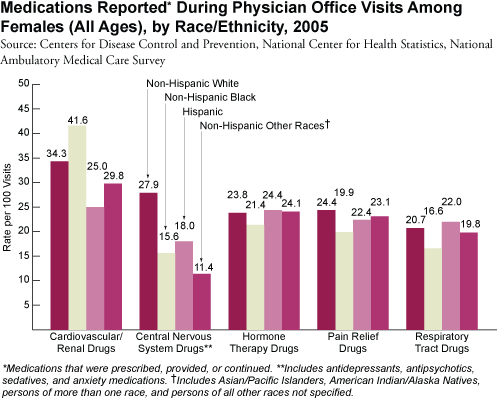Medication Use
In 2005, medication was prescribed or provided by a physician at nearly 680 million, or 70.5 percent of, physician office visits; multiple drug prescriptions were recorded at 45.9 percent of all visits. The percent of visits with one or more drugs prescribed or provided was similar for males and females (70.9 and 69.9 percent, respectively). Among females of all ages, 29.1 percent of visits did not involve prescribing or providing any drugs, 24.9 percent of visits involved the prescription or provision of one drug, and 14.0 percent of visits involved two drugs. An additional 32.1 percent of visits involved the prescription or provision of 3 or more drugs.1
The prescription and provision of medications to females varies by race/ethnicity and drug type. In 2005, the rate of cardiovascular/renal drugs prescribed or provided at physician office visits was highest among non-Hispanic Black females (41.6 per 100 office visits), while non-Hispanic white females were most likely to receive central nervous system drugs (anti-depressants, antipsychotics, sedatives, and anxiety medications; 27.9 per 100 visits). Hispanic females were the most likely to have respiratory tract drugs provided or prescribed (22.0 per 100 visits). There was little variation between females of different races and ethnicities in the use of hormone therapy drugs. The rate of medications provided and prescribed to females during physician office visits also varies by age. For instance, women aged 45–64 years were the most likely to have central nervous system drugs prescribed or provided (34.1 per 100 visits), while women aged 75 and older were most likely to receive cardiovascular/renal drugs (85.9 per 100 visits) and pain relief drugs (34.6 per 100 visits). Respiratory drugs were most likely to be prescribed or provided to girls under 15 years of age (25.9 per 100 visits, data not shown).
1 Cherry DK, Woodwell DA, Rechtsteiner EA. National Ambulatory Medical Care Survey: 2005 Summary. Advance data from vital and health statistics; no 387. Hyattsville, MD: National Center for Health Statistics. 2007. http://www.cdc.gov/nchs/about/major/ahcd/adata.htm, accessed 01/14/08.↑

